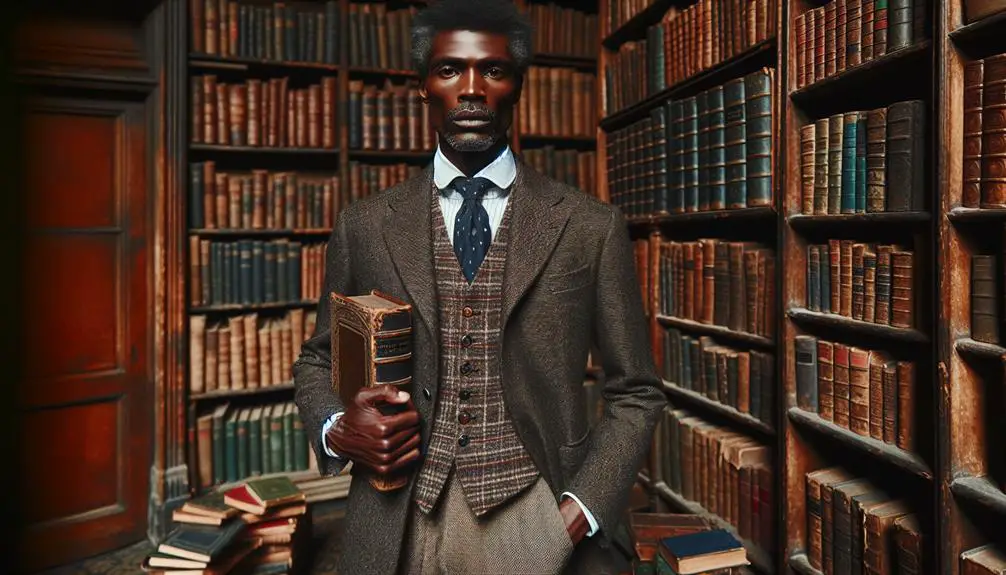I've always found tweed to be a fascinating topic, especially when it comes to its formality. Traditionally, it's seen as quite formal due to its roots with the British aristocracy, but isn't it interesting how it also fits so seamlessly into more casual looks? The versatility of tweed, with its rich textures and patterns, really makes you wonder where it stands in today's fashion. Is it still holding on to its formal heritage, or has it evolved into something more laid-back? Let's unpack this a bit and see where tweed is making its mark now.
Table of Contents
Key Takeaways
- Tweed is traditionally formal, often worn by British aristocracy in formal settings.
- Modern adaptations have made tweed suitable for both casual and formal wear.
- Tweed suits are ideal for business and professional environments, offering a polished look.
- In formal events, tweed provides an elegant yet durable choice that balances sophistication with practicality.
- Accessories like tweed ties or hats can add a touch of class to more formal attire.
Origins of Tweed Fabric
Tweed fabric first popped up in Scotland during the 18th century. It wasn't just another textile; its emergence was a response to the harsh, unpredictable Scottish weather. I've always been fascinated by how Tweed production initially was a purely local affair. Farmers and locals would use wool from their sheep, spinning, dyeing, and weaving it into Tweed right at their homes or nearby mills.
The real kicker about Tweed is its resilience. This fabric isn't just tough; it's practically heroic in its ability to resist wind and dampness. Perfect for Scottish climes, right? This durability comes from the tightly woven wool, which also naturally repels water. As I dug deeper, I discovered that the initial methods of hand-weaving provided Tweed with its distinctive, rugged texture, enhancing its toughness.
Tweed in Historical Fashion
Now let's look at how Tweed made its mark in historical fashion. Originating from Scotland, this fabric wasn't just a style statement; it was a necessity owing to its exceptional durability. Tweed's ability to withstand harsh climates made it indispensable for outdoor activities. Over time, these practical roots influenced its integration into more formal attire, particularly among the British aristocracy.
Digging deeper into the production techniques, it's fascinating to see how traditional methods have preserved the quality of tweed over centuries. The fabric is typically made from wool, but what sets it apart is the intricate way in which the wool is woven. This process not only contributes to its durability but also to its distinctive texture. Historically, the production of tweed involved local artisans who mastered the skill of tightly weaving the wool, enhancing its natural water-resistant properties.
These historical aspects of tweed reveal why it transcended its utilitarian origins to become a staple in fashion. Its resilience and the meticulous production process helped establish tweed as a symbol of both practicality and class. As a result, it successfully bridged the gap from functional outdoor wear to an emblem of sophisticated style, continuing to evolve while maintaining its historical essence.
Types of Tweed Patterns
Let's explore the various patterns that make tweed such a unique fabric. Tweed's allure isn't just in its rugged warmth but also in the intricate weaving techniques that give rise to a range of patterns, each enhancing the fabric's durability and aesthetic appeal.
Here's a breakdown of some classic patterns:
- Herringbone: This v-shaped weaving pattern resembles the skeleton of a herring fish. It's not only visually striking but the alignment of the fibers also enhances the durability of the fabric, making it a popular choice for both fashion and function.
- Check: Comprising horizontal and vertical stripes that create a crossed pattern, check tweed is versatile and widely recognized. Each intersection adds to the fabric's strength, resisting wear and tear in style.
- Barleycorn: This pattern shows a more textured look, resembling the kernel of barley. It's the weaving technique here that adds depth to the fabric, making it exceptionally durable and perfect for outerwear.
- Plaid: Often used interchangeably with tartan, plaid tweed incorporates a multi-colored pattern of crisscrossed horizontal and vertical bands. Each color weave not only adds complexity but also reinforces the fabric's structure.
These patterns showcase the incredible craftsmanship behind tweed, making it a timeless choice in both fashion and durability.
Tweed in Modern Wardrobes
Despite its traditional roots, I've found tweed to be surprisingly adaptable in modern wardrobes. It's not just for the professors or country gentlemen anymore. I'm seeing tweed pop up in the most unexpected places, from sleek streetwear jackets to chic, minimalist skirts. The fabric's rugged charm and texture lend a unique edge that modern fashionistas can't seem to get enough of.
One of the coolest things lately is the push towards tweed innovations. Designers are experimenting with lighter weights and blending tweed with other materials to create garments that aren't only stylish but also more comfortable and versatile. This means tweed isn't confined to the colder months; it's becoming a year-round staple.
Moreover, the focus on sustainability has brought tweed recycling to the forefront. Old tweed garments are being repurposed into everything from accessories like bags and hats to entirely new articles of clothing. It's a fantastic way to keep the tweed legacy alive while staying eco-friendly. These efforts are reshaping how we think about tweed, turning it from a symbol of the old-school into a beacon of modern, sustainable fashion.
Dress Codes and Tweed
When it comes to dress codes, tweed is surprisingly flexible.
I've seen it dressed up for business meetings and styled casually for weekend outings.
It even makes an appearance at more formal events, proving its versatility across various social settings.
Tweed in Business Attire
Incorporating tweed into business attire can subtly elevate your professional look. This traditional fabric isn't just for the countryside anymore; it's making a mark in the city too. Here's how to nail it:
- Choose Subtle Patterns: Stick to minimal, classic patterns. Overly busy designs can undermine the sharp look you're aiming for.
- Opt for Refined Textures: Not all tweed textures suit the boardroom. Select finer, smoother tweeds that communicate sophistication.
- Mind the Fit: Guarantee your tweed suits are well-tailored. A good fit speaks volumes about your professionalism.
- Durability Matters: Tweed's durability makes it a practical choice for daily wear, saving you from frequent replacements.
Mastering tweed in business settings isn't just about fashion—it's about making a statement of reliability and style.
Casual Settings: Tweed's Versatility
Tweed isn't just for formal occasions; it's also perfect for adding a touch of class to your casual wear. I love tossing on a tweed jacket for a laid-back outing. It's not only stylish but the fabric's durability makes it ideal for everyday use. Tweed accessories, like caps or bags, also blend seamlessly into a casual wardrobe, providing both function and flair.
Pairing tweed with jeans or chinos strikes a fine balance between looking put-together and feeling comfortable. The material's robust nature means it can handle a bit of rough and tumble, making it a smart choice for casual settings where you still want to look sharp without going overboard.
Tweed at Formal Events
I've found that a well-tailored tweed suit can be the perfect choice for many formal events, striking an elegant balance between traditional and unique. When considering tweed textiles for these occasions, you must assess the event appropriateness carefully.
Here's a quick guide:
- Weddings: Opt for a lighter tweed in softer shades to keep things festive yet sophisticated.
- Business Events: Choose a darker, well-fitted tweed suit that communicates professionalism and style.
- Dinners: A mid-weight tweed blazer over a fine shirt strikes the right note of relaxed formality.
- Gala Events: Pair a classic tweed jacket with a bow tie for a touch of old-school charm that's still completely on point.
Mastering tweed's use in formal settings really sets you apart!
Tweed in Business Attire
So let's talk about how tweed fits into the business world.
Tweed suits are surprisingly versatile, easily dressing up or down depending on the occasion.
We'll also look at how modern designers are reinterpreting tweed for today's office environment.
Tweed Suit Versatility
In recent years, a tweed suit has proven itself remarkably versatile in business settings, blending traditional style with modern professionalism. Here's why I believe it's a great choice:
- Seasonal Flexibility: Tweed's natural insulation makes it perfect for colder months, but lighter weaves are also comfortable in warmer seasons. This seasonal tweed adaptability means you can wear it almost year-round.
- Durability: Tweed's tight weave contributes to its longevity. It resists wear and tear better than many other fabrics, making it a smart investment.
- Professional Yet Unique: A tweed suit stands out subtly in a sea of standard business attire, offering a distinctive but professional look.
- Versatile Pairing: It pairs well with both casual and formal pieces, increasing outfit options.
Modern Tweed Interpretations
While tweed has long been a staple in classic wardrobes, it's now making a significant mark in modern business attire as well. Tweed technology and innovations are transforming this traditional fabric into a chic, versatile choice for the office. It's not just about the old-school thick jackets anymore. Today's tweed can be sleek and sophisticated.
Here's a quick look at how tweed fits into today's business world:
| Feature | Detail |
|---|---|
| Material | Lightweight, breathable tweed |
| Design | Modern cuts and slim fitting styles |
| Functionality | Durable and maintains shape |
| Style | Available in various colors and patterns |
| Innovation | Incorporation of smart fibers |
Tweed's revamp with modern tailoring makes it a smart pick for anyone wanting to blend tradition with trend.
Styling Tweed for Events
Choosing the right tweed outfit for events can elevate your style considerably. When I'm gearing up for a gathering, I always consider the vibe of the event and the latest in tweed. Here's how I decide:
- Match the Event's Formality: For formal occasions, a well-tailored tweed suit is unbeatable. I opt for darker colors like navy or charcoal. For casual events, a tweed blazer over a light shirt does wonders.
- Seasonal Tweed Trends: I stay updated with seasonal variations. Autumn calls for richer, earthy colors, while spring welcomes lighter shades. Tweed's versatility means there's always a trendy option that fits the season.
- Tweed Accessories: Don't overlook the power of accessories. A tweed cap or a pair of tweed shoes can tie your outfit together without overwhelming it.
- Layering: Layering is key, especially in unpredictable weather. A tweed vest can add depth to your outfit and extra warmth when needed.
Tweed Across Cultures
Tweed isn't just a staple in British closets; it's made a mark worldwide.
I'll explore how it fits into British fashion and how its influence has spread globally.
It's fascinating to see how a fabric can weave its way through so many cultures.
Tweed in British Fashion
In British fashion, tweed stands as a symbol of timeless style and cultural identity. Its versatility and durability aren't just about keeping warm; they're about making a statement. Here's how tweed keeps evolving:
- Tweed Accessories: From chic hats to stylish bags, tweed accessories are must-haves that add a pop of personality and class.
- Tweed Innovations: Modernizing the traditional, designers are integrating tech with tweed, like incorporating waterproof finishes.
- Designer Collaborations: High fashion brands often merge with heritage mills to create unique, high-quality tweed.
- Sustainable Practices: More brands are pushing for eco-friendly methods in tweed production, ensuring fashion doesn't cost the earth.
Tweed isn't just a fabric; it's a craft that's been woven into the very fabric of British identity.
Tweed's Global Influence
As we explore tweed's global reach, it's clear that this fabric has made its mark far beyond British shores. Tweed production has evolved, with countries from Japan to the United States weaving their unique versions of this traditionally British textile. It's fascinating to see how tweed adapts to different cultural aesthetics while maintaining its heritage roots.
Moreover, tweed sustainability has become a hot topic globally. As the demand for eco-friendly fabrics rises, tweed producers are stepping up, using sustainable practices to lessen environmental impact. This shift isn't just good for the planet; it also resonates with consumers worldwide who value sustainability. This global embrace challenges the notion that tweed is merely a British relic—it's a versatile, enduring fabric loved worldwide.
Caring for Tweed Garments
Taking proper care of your tweed garments guarantees they last and look great for years. Here's how to keep them in top condition:
- Wash Sparingly: Tweed doesn't need frequent washing. When it does need a clean, opting for a gentle hand wash or a professional dry clean will help maintain its shape and texture. Overwashing can wear it out, so be cautious.
- Proper Storage: Hang your tweed using padded hangers to keep the shoulders in shape. For long-term storage, use a breathable garment bag to protect from dust and moths, which can wreak havoc on tweed's natural fibers.
- Dealing with Allergies: If you're prone to tweed allergies, regularly airing out the garment can help reduce irritation. Consider using hypoallergenic fabric liners or sprays to create a barrier against the fibers.
- Tweed Recycling: Don't throw away old or worn-out tweed! Tweed can be recycled or repurposed into other items like bags, cushions, or even artwork. This not only extends the life of the fabric but also supports sustainable fashion practices.
Future of Tweed Fashion
While we've explored how to care for tweed, let's now look at its evolving role in the fashion world. Tweed has always been a symbol of class and durability, but with the latest innovations in tweed technology, it's becoming more than just a fabric—it's a statement of sustainability and forward-thinking design.
The future of tweed fashion is undeniably exciting. Designers are now harnessing advanced tweed technology to create fabrics that aren't only visually appealing but also environmentally friendly. Sustainable tweed is the buzzword here, folks. This means using organic materials and eco-friendly practices to produce tweed that helps reduce the fashion industry's carbon footprint. It's not just about looking good anymore; it's about feeling good about what you wear.
Moreover, the integration of technology allows for tweed to be more adaptable and comfortable, making it suitable for a wider range of climates and occasions. This versatility ensures that tweed remains relevant in the rapidly changing world of fashion.
Frequently Asked Questions
Can Tweed Be Dyed to Custom Colors?
Yes, tweed can be dyed to custom colors using specific dyeing techniques to guarantee color durability. I've experimented with various methods and found that proper technique is essential for vibrant, lasting results.
Is Tweed Suitable for Summer Wear?
I'd say tweed isn't ideal for summer wear. It's typically thick, so heat management can be tricky, compromising summer comfort. Lighter fabrics are better for keeping cool when it's hot out.
How Does Tweed Impact the Environment?
Tweed production's environmental impact largely hinges on fiber sourcing. If sourced sustainably, it's less harmful. However, conventional methods can strain resources and ecosystems, demanding more responsible practices in its manufacturing process.
Are There Vegan Alternatives to Tweed?
Yes, there are vegan alternatives to tweed that focus on fabric sustainability and ethical sourcing. These include materials like cotton, linen, and synthetic blends that don't compromise on style or environmental responsibility.
Does Tweed Offer Any Insulation Properties?
Yes, tweed's thickness and moisture resistance make it quite insulating. It's great for chilly, damp weather because it traps heat well and repels water, keeping you warm and relatively dry.
- How Does Ring Spun Cotton Affect Garment Fit and Shape Retention? - August 13, 2024
- What Are the Challenges in Producing Ring Spun Cotton? - August 13, 2024
- Is Ring Spun Cotton Suitable for Plus-Size Clothing? - August 13, 2024







